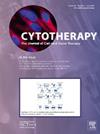Human amnion epithelial cells and secretome drive the generation of tolerogenic macrophages and decidua-like NK cells with lower proliferative capability and higher effector functions
IF 3.7
3区 医学
Q2 BIOTECHNOLOGY & APPLIED MICROBIOLOGY
引用次数: 0
Abstract
Background & Aim
Pregnancy is characterized by major immunomodulatory strategies. We previously reported different immune regulatory properties offered by amnion epithelial cells (AEC), isolated from term human placentae. Once transplanted in immune-competent recipients, AEC engrafted and survived, boosting the innate capacity for regeneration. Previous reports described AEC interaction with immune cells (B and T) promoting anti-inflammatory phenotypes, such as regulatory T cells.
Methodology
Now, we investigated AEC effects on macrophages and NK cells. Since AEC therapeutic potential is not mediated by intact cells only, we tested the ability of AEC secretome (AES) to modulate NK and macrophage proliferation, phenotype and functions.
Results
The amount of NK cells was reduced in the presence of AES. The expression of CD57, NKG2C, CD16, and TIGIT was downregulated, whereas the expression of NKG2A, NKp30, NKp46, and NKp44 increased. FACS analysis of surface CD107a expression revealed NK cell cytotoxicity increased (from 12.9% to 27.8%) upon exposure to AES., and cytotoxicity towards K562 cells (26.9%) increased almost 3-fold (73.7%).
Similarly, M2 macrophages increased in a dose-dependent manner. However, such effect was mainly mediated by soluble factors, such as M-CSF, and the vesicular component (AEC-derived EVs) failed to induce M2 polarisation. The extracellular vesicles and proteins released by primary human AECs were quantified by targeted proximity extension assay and several protein of interest, such as VEGF, IL-12B, or M-CSF, were found constitutively expressed, even in hypoxic conditions.
Conclusion
Our preliminary results suggested that secretome of AEC may drive the generation of NK cells with decreased proliferative ability and expression of senescence/exhaustion markers (CD57, NKG2C and TIGIT) and increased cytotoxicity receptor expression (NKG2A, NKp30, NKp44 and NKp46). Accordingly, such NK cells are more cytotoxic against leukemia target cells.
Collectively, our findings support the allogeneic transplantation of human AEC and their active role in local immune regulation, particularly in medical conditions where macrophage response needs to be modulated and contained.
Based on these and largely described immunomodulatory effects on adaptive and innate immune cells, allogeneic AEC-based treatments without immunosuppressants are legitimate, as well as novel cyto-therapeutic strategies for inflammatory disorders and auto-immune conditions.
人羊膜上皮细胞和分泌组驱动产生耐受性巨噬细胞和蜕膜样NK细胞,其增殖能力较低,效应功能较高
背景,目的妊娠以主要的免疫调节策略为特征。我们以前报道过从足月人胎盘中分离的羊膜上皮细胞(AEC)具有不同的免疫调节特性。一旦移植到免疫能力强的受者体内,AEC就会植入并存活,增强了先天的再生能力。先前的报道描述了AEC与免疫细胞(B和T)的相互作用,促进抗炎表型,如调节性T细胞。方法研究AEC对巨噬细胞和NK细胞的影响。由于AEC的治疗潜力不仅仅由完整细胞介导,因此我们测试了AEC分泌组(AES)调节NK和巨噬细胞增殖、表型和功能的能力。结果AES作用下NK细胞数量明显减少。CD57、NKG2C、CD16、TIGIT表达下调,NKG2A、NKp30、NKp46、NKp44表达上调。表面CD107a表达的FACS分析显示,暴露于AES后NK细胞的细胞毒性增加(从12.9%增加到27.8%)。对K562细胞的细胞毒性(26.9%)增加了近3倍(73.7%)。同样,M2巨噬细胞呈剂量依赖性增加。然而,这种作用主要是由M-CSF等可溶性因子介导的,而囊泡成分(aec衍生的ev)未能诱导M2极化。通过靶向邻近扩展法定量了原代人aec释放的细胞外囊泡和蛋白质,发现即使在缺氧条件下,VEGF、IL-12B或M-CSF等几种感兴趣的蛋白质也组成性表达。结论AEC分泌组诱导NK细胞增殖能力下降,衰老/衰竭标志物(CD57、NKG2C和TIGIT)表达下降,细胞毒性受体(NKG2A、NKp30、NKp44和NKp46)表达增加。因此,这种NK细胞对白血病靶细胞具有更强的细胞毒性。总的来说,我们的研究结果支持人类AEC异体移植及其在局部免疫调节中的积极作用,特别是在需要调节和控制巨噬细胞反应的医疗条件下。基于这些以及对适应性和先天免疫细胞的免疫调节作用,不使用免疫抑制剂的同种异体aec治疗是合法的,也是炎症疾病和自身免疫疾病的新细胞治疗策略。
本文章由计算机程序翻译,如有差异,请以英文原文为准。
求助全文
约1分钟内获得全文
求助全文
来源期刊

Cytotherapy
医学-生物工程与应用微生物
CiteScore
6.30
自引率
4.40%
发文量
683
审稿时长
49 days
期刊介绍:
The journal brings readers the latest developments in the fast moving field of cellular therapy in man. This includes cell therapy for cancer, immune disorders, inherited diseases, tissue repair and regenerative medicine. The journal covers the science, translational development and treatment with variety of cell types including hematopoietic stem cells, immune cells (dendritic cells, NK, cells, T cells, antigen presenting cells) mesenchymal stromal cells, adipose cells, nerve, muscle, vascular and endothelial cells, and induced pluripotential stem cells. We also welcome manuscripts on subcellular derivatives such as exosomes. A specific focus is on translational research that brings cell therapy to the clinic. Cytotherapy publishes original papers, reviews, position papers editorials, commentaries and letters to the editor. We welcome "Protocols in Cytotherapy" bringing standard operating procedure for production specific cell types for clinical use within the reach of the readership.
 求助内容:
求助内容: 应助结果提醒方式:
应助结果提醒方式:


